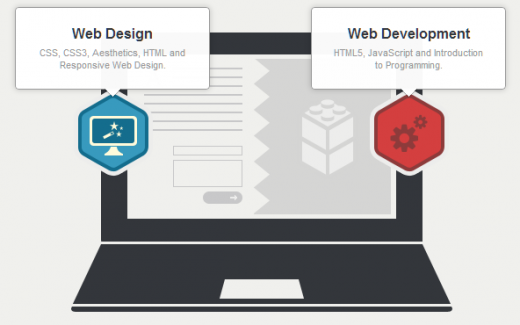
Rosie Allabarton is a writer who lives in Berlin. Her journalism specializes in technology, education, employment and women in technology. She works as a tech writer and content manager for CareerFoundry, an online educational platform that provides training in web development and UX design, providing career changers with the skills they need to launch themselves onto the tech scene.
In the last couple of years we’ve all heard scare stories of the ‘tech skills gap’, in particular, a skills gap in programming, that threatens to forestall current progress in technology and leave millions out of work. Stories of graduates leaving university unable to land jobs because of a deficit in their technological education are often reported.
With unemployment in both Europe and the US on the increase, the question is no longer who is responsible for providing tech education to the masses, but instead what can we as individuals do to close that widening gap and make ourselves relevant to the job market?
First of all, we need to look at the problem. A study funded by Microsoft in 2013 reported that there are 120,000 new jobs created in the United States each year that require the skills of workers with degrees in Computer Science. However, in the US only 49,000 graduates leave university with Computer Science degrees annually creating a gap of 71,000 available jobs.
These are jobs that remain ‘open’ due to a shortfall in applications from so-called ‘qualified’ candidates, or at least candidates these companies deem to be qualified. We can then assume that with so many positions not being filled, there is an inevitable slowing-down of advances in the field.
As is already well-documented, there exist 11 million US workers who are currently unemployed, so despite the fact that there are 4 million jobs unfilled, and millions of people out of work, those who are out of work are either ill-qualified, unwilling or feel unsuited to applying for these jobs.
This statistic would directly infer that while there are job opportunities available, those out of work simply don’t have the skills to apply for them, or don’t want to. Obviously this discrepancy between supply and demand isn’t just relevant to technology or STEM subjects, but with the technology industry expanding at such a rapid rate, and schools only recently latching on to the importance of tech education, it was an inevitable trend in technology that should have been addressed long before it reached crisis point.
This problem of the tech skills gap in the US is further confirmed when we look at pay. Salaries for information technology jobs are rising 5.1 percent per year, a rate that is 45 percent higher than an average job in America. These sharply rising salaries show clearly that with demand so high, companies are being forced to pay out larger salaries to those who do have the right skills just to incentivize them to join their company and to keep them on board once they’re there.
If any more reasons were needed to get trained up in technology aside from guaranteed work, flexible lifestyle, creative output and an impact-making occupation, the welcoming pay package that greets many new IT recruits could certainly be another one.
And what can we expect over the next five years? Well, if the current tech skills gap wasn’t worrying enough, reports have shown that employment in professional, scientific and technical services is projected to grow by 29% by the year 2020, with this increase adding more than two million new jobs to the US economy alone.
Although an increase in employment opportunities can only be a good thing, the McKinsey World At Work report has found that even with preventative measures, there could still be 20 to 23 million workers in advanced economies without the skills employers will need in 2020.
What can you do to close the gap?
As individuals begin to look for their own personalized solutions to acquiring knowledge in technology and enter the job market, many tech bootcamps have sprung up to meet this need.
By creating courses suitable for total beginners in the field, innovative startups and entrepreneurs are giving keen learners the chance to make their mark in this expanding and fast-paced industry, helping them find jobs in a market that is beginning to insist on some basic knowledge of technology in almost every position.
These startup-ran bootcamps are offering individuals what schools and universities have ultimately failed to: knowledge and skills that give individuals a high market value and guarantee of a good income, a flexible and diverse workload, impact-making opportunities and creative freedom in their working lives.
Where are the best places to learn?
If you’re interested in taking advantage of the opportunities the tech skills gap has created, take a look at the list of schools and bootcamps below that are making programming knowledge accessible to beginners, personalized and available online. By engaging in an immersive program you can begin your coding journey as a beginner and leave it as a professional with highly sought-after skills for the current job market.
CareerFoundry
Learning code is easier together. The team at CareerFoundry, Europe’s leading online platform for courses in Web Development and UX Design, have built their whole business around this concept. Working with complete coding beginners the Berlin startup works personally with each student, passing on sought-after tech skills via online courseware which is taught by expert mentors.
With its outcome-orientated approach the Berlin startup has garnered rave reviews from the tech scene and educationalists worldwide. The key for CareerFoundry is teaching coding with a learning-by-doing methodology, so each student feels like they are an active apprentice to their very own mentor.
Selling point: CareerFoundry helps you learn to code from the comfort of your own home (or wherever you happen to lug your MacBook). But what makes CareerFoundry stand out from other online offerings is its focus on mentorship. Every CareerFoundry student is paired with an experienced mentor who will not only guide them through their learning but also help them kickstart their career in tech.
Treehouse
Based in Portland, Oregon, Treehouse is another solely online platform that offers courses in web development. Its core focus is on beginners looking to start a new career, guiding them through video tutorials, interactive coding challenges, quizzes and badges to give them a grasp of the problem-solving nature of the industry. Although not mentored, Treehouse is an affordable, online and accessible option for many wannabe coders to get their grounding in the field.
Selling point: Score points as you complete tasks so you can easily track your progress
Bloc
San Fransisco-based Bloc.io offers full stack web development, iOS, Android and UX design. With both full time and part time courses available these online programs are suitable for those with full time jobs or families. Projects are based around portfolio-building and all courses are mentored. The ideology behind Bloc is that it is a course-to-career, hands-on training program rather than simply a theory-based education.
Selling point: Bloc’s mentor-based intensive program is designed as a course-to-career training program
Thinkful
Thinkful’s package focuses predominantly on front-end web development for those who would class themselves as beginner-to-intermediate. Thinkful’s 11 courses cover front-end web development, HTML, CSS, JavaScript, Python, iOS, Node.js, jQuery and Git and all are mentored. With customized curriculums and quick-responding community support, Thinkful really puts its students at the centre of the learning experience.
Selling point: Community focus that groups students into skill groups for additional support
Codecademy

It throws you in at the deep-end doing code with their ‘console’ approach from the start. Great for beginners who can see straight away what coding would be like as a professional. Theory and background in coding would definitely be advantageous but there is a support network of students and the CA team to keep you on track.
Selling point: Codecademy prides itself on being the world’s first truly net native educational offering
You’ve got the skills, so what do you do now?
As you have probably realised by now, just having a decent knowledge of programming is probably not going to be enough to land you that front-end developer position at Apple. But don’t despair. You’ve done the hard work – learning to code – now all you need to do is build on that by following the steps below to get your foot on the ladder of your new tech career.
Find your niche
Wanna stand out from the crowd? Find yourself a niche and upgrade your skillset. While it’s great to be a programmer that can do a bit of everything, your value will be higher as an expert in just a few. It will also make you easier to find, and in this field never forget that you are who Google says you are.
If you’re not sure your current abilities solve a common enough problem, consider learning a new language altogether, or try building a skillset of complementary abilities other than coding, such as User Experience Design, or User Interface Design for the more creative types. A developer who can also plan out a usable and effective information architecture is rare, and this dual-skilled approach could see you turning potential employers away left, right and centre.
Start building
So you’ve found your niche. Now it’s time to get building. The best place to start is your portfolio website, the one website you will update, edit and continually develop for your entire career (check out our feature on which website builders to use).
Your portfolio is a way of displaying your skills and is an easy reference for potential employers or clients (if you’re going freelance). If in doubt, remember that your goal in self-representation is to be easy to find, easy to remember, and good to know. Use your personal site to experiment with ideas, and practice, practice, practice.
Work on your personal brand
Getting your name out there as an expert in the field can be tough both online and off, but it’s a crucial step to launching your career. There are so many opportunities for professionals to get known without spending a penny that advertising is not a route you need to go down, not at this stage.
By showcasing your work, building a network and teaching and blogging like an expert you will find more than enough ways to connect with people and for people to find you. Don’t forget to go to local events and meet people in person – you’re much more likely to be remembered that way, it can be a great networking opportunity and it’ll be the first place you’ll hear about job opportunities.
Good websites for getting your name out there are:
Take on small jobs
To build up your experience start taking on small programming jobs for friends and family. Advertise your skills locally or on sites like Craigslist and see if local schools, charities or churches need websites built for them.
These kinds of jobs are great for building up your confidence and earning a bit of money (though don’t expect big budgets) and putting your new skills into practice in the real world. Word of mouth recommendations are worth a lot to you at this stage, as well as the opportunity to build up your portfolio so make sure you do a good job and you are likely to be offered more work off the back of it.
Conclusion
The tech skills gap may be widening but for many this is an opportunity. With the right education, guidance and experience, this highly paid, creative, challenging and varied work is yours for the taking.
Read Next: Introducing TNW Jobs
Get the TNW newsletter
Get the most important tech news in your inbox each week.












